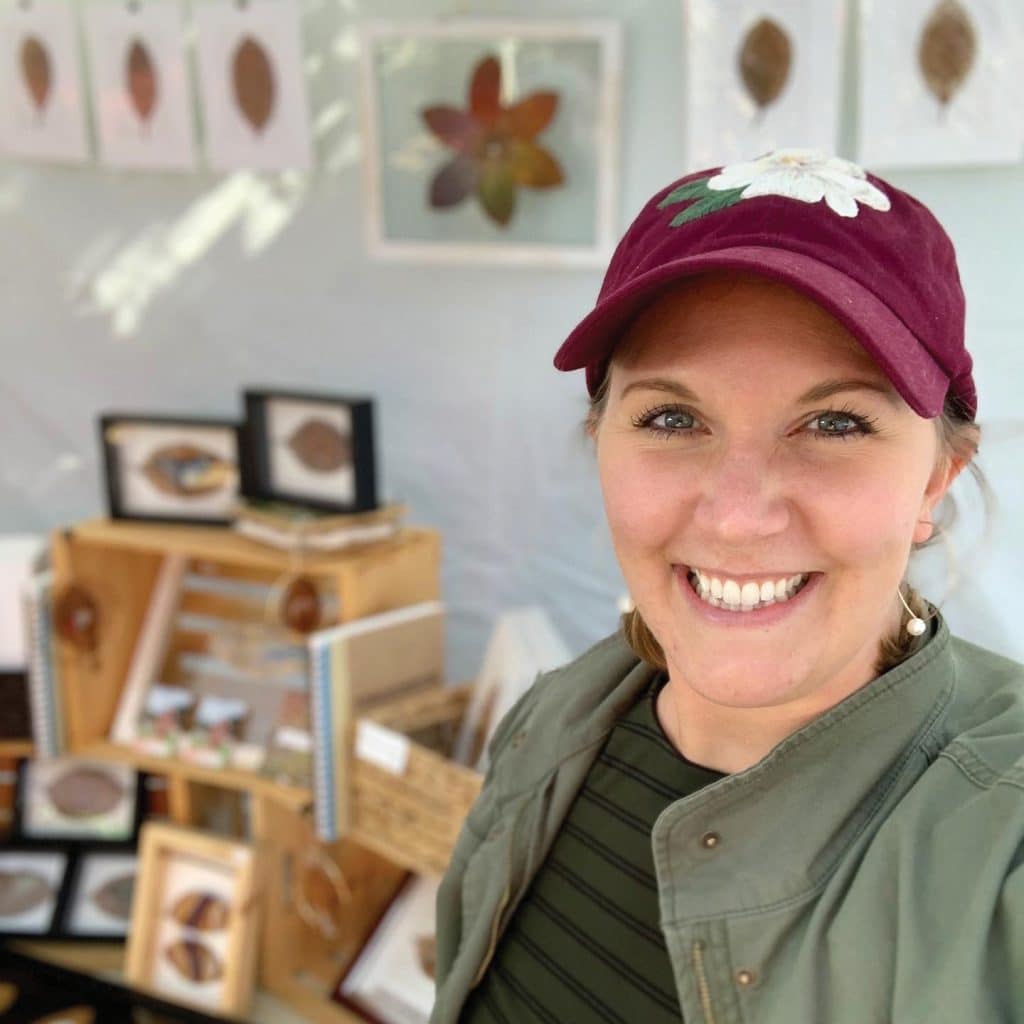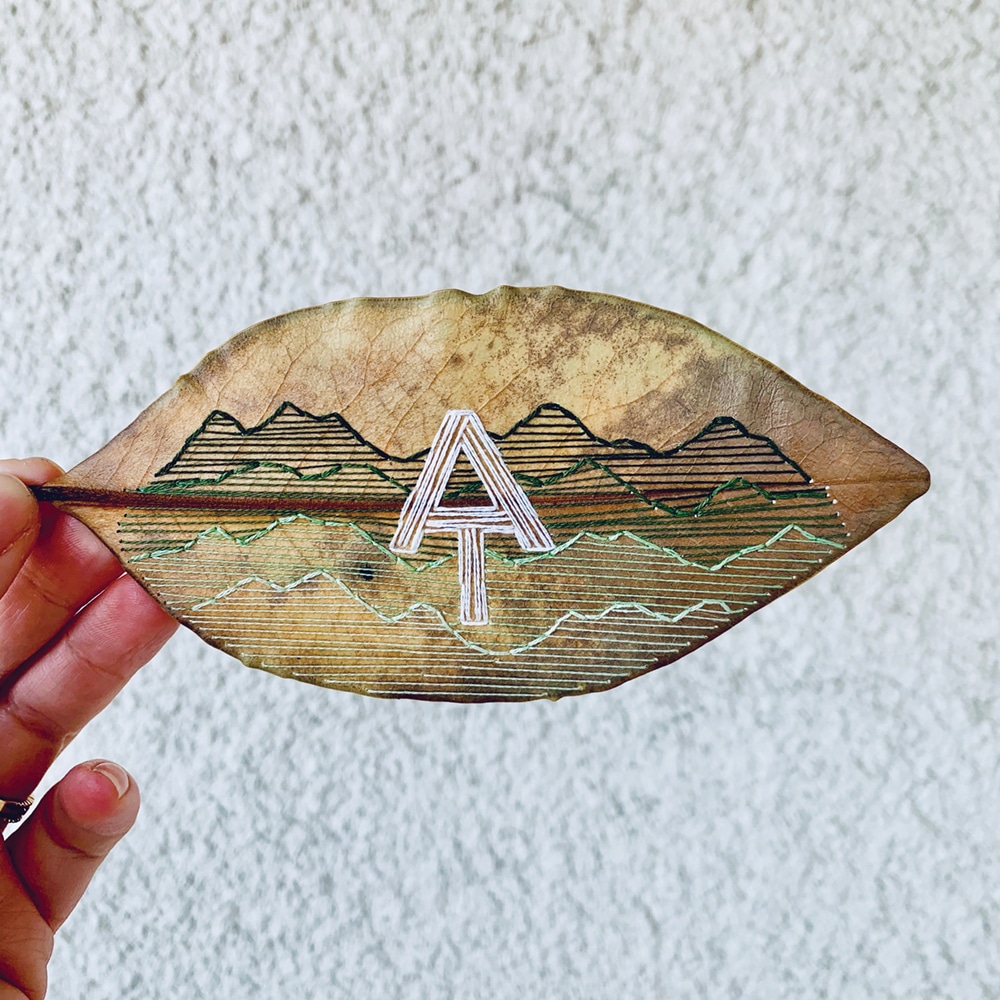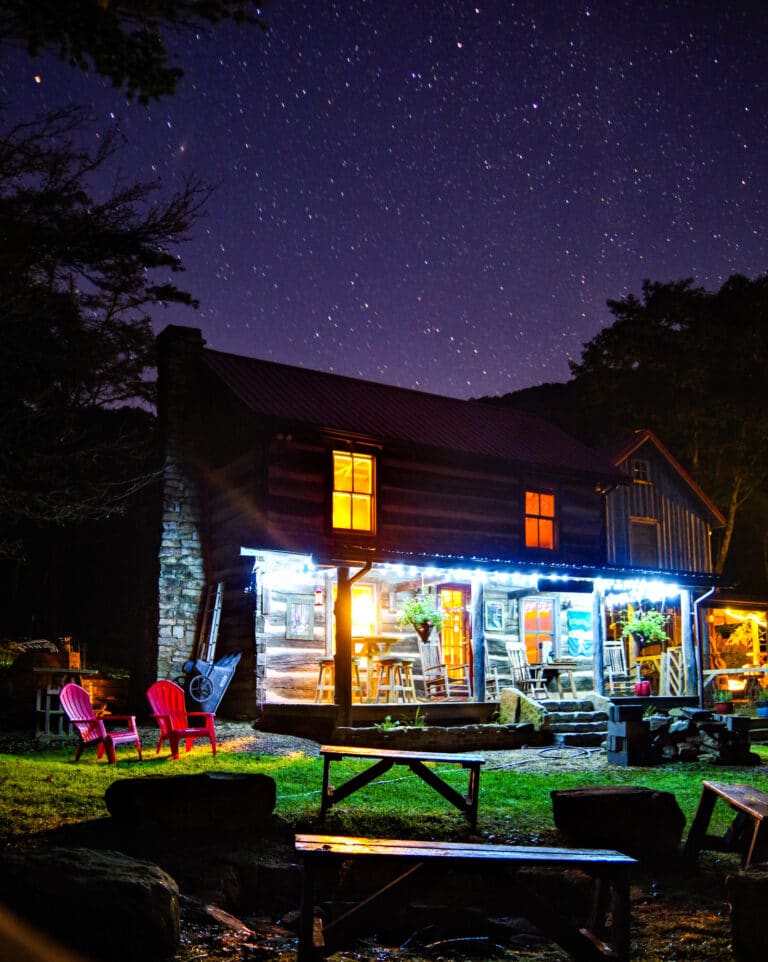Press, dry, embroider, repeat. Each of Heather O’Donnell’s hand-embroidered magnolia leaves is carefully stitched to create a one-of-a-kind piece.
When you see leaves on the ground, you might think about the changing of seasons, the passage of time, or the fragility of life. A pile of leaves could symbolize something to play in or more yardwork to add to the list. But when Heather O’Donnell sees leaves, she sees a blank canvas. Working specifically with magnolia leaves, she embroiders the natural surface with everything from geometric designs and scenes from nature to house and pet portraits to create timeless keepsakes and intricate pieces of art.
Originally from Wisconsin, O’Donnell didn’t grow up with magnolia trees around her. So when she moved to Georgia to study architecture at Savannah College of Art and Design, the magnolia trees immediately stood out in her mind. “I realized pretty quickly that I was afraid of computers,” O’Donnell said. Looking for something more tactile and hands on that would get her out from behind a computer, she made the switch to a degree in fibers.
During O’Donnell’s senior year, inspiration struck as she was doodling with thread. Running outside during class, she picked up a few magnolia leaves to use instead of a cloth or paper canvas.
“If you talk to anyone who’s ever had a magnolia tree in their yard, you’ll know that they stick around,” O’Donnell said. “I get so many people asking about them breaking down and disintegrating. These leaves are hardy as all get out. They will last forever.”
When people ask O’Donnell if she plans to experiment with other types of leaves, there’s a part of her that doesn’t want to. “I think I’d like to play with it in the future but I’ve developed this brand as Magnolia Heather,” she said. “I don’t mind that. I don’t think it’s a restriction on who I am as an artist or restriction on the work I create. There’s so much more I can do with the leaves themselves and they just have proven to be such a good canvas to work with.”

The Technique
When it comes to choosing the perfect leaf, O’Donnell can be pretty particular about things like shape, size, and color. “I prefer to choose the leaves that have already fallen because that way I’m not disturbing their life cycle and I really am upcycling nature,” she said. She also tends to avoid green leaves because the drying process is so unpredictable, leaving colors ranging from a light green to spotty and brown, and working with a non-neutral color makes it harder to pick out threads.
Over the years, O’Donnell has picked out a few go-to trees around town, like the tree outside of her office. Before work or on her lunch break, she’ll pick up leaves from the ground that might work. Or, if she’s out on a walk and comes across the right type, she’ll pick them up and find a place on her person to store until she gets back home. Once she’s collected the leaves, O’Donnell cleans, presses, and dries them so they will keep their shape and the colors bright. Other than that, she doesn’t use any lacquer or preservative spray. “I try to keep them as natural as possible,” she said. Most of her designs are made to go behind glass so they last even longer.
With a stockpile of collected leaves, O’Donnell works heavily in sketchbooks to create a design on such a tiny space. “I feel like so much can get lost in computers,” she said. “That’s just a personal thing, which is funny because at my day job [designing rugs], I work in the computer. So when it comes to my work, I very much like referencing back to the book, turning the page, and putting the pencil on the paper.”
Although the leaves are pretty thick, O’Donnell generally creates a pattern to trace, allowing her to pre-poke holes so she doesn’t rip or tear them. “I’ve gotten to know them,” she said. “But there are some that do end up being more brittle or thinner than others, if my thread gets tangled while I’m pulling the thread, if I get too comfortable and accidentally pull through too hard—it does happen. But I’m pretty good at covering it up with thread or finding a way to make it work.”

Finding Balance
Although she has worked in this medium for five years, O’Donnell said she is still trying to figure out her place in the art world. “It took me a long time to even call myself an artist and believe it,” she said. “I say I am an artist but I still have so many times of doubt.”
While she does make some “quick sells” and attends art markets, like the Marietta Square Artisan Market in Georgia, O’Donnell hopes viewers look at her pieces as meaningful works of art. “I think there’s this stigma out there of craft versus art,” she said. In the future, she’s hoping to work on a larger scale, incorporating more leaves into a single piece, to see how far she can take the materials. “I go into things with all my heart and really dedicate myself to it,” O’Donnell said. “But I also don’t believe that no one can do what I do. If you want to try it out, put the time into it.”
After years developing her brand as Magnolia Heather, O’Donnell prides herself on maintaining a healthy balance between her art and life. “You have to remember that while you are hustling, if you hustle too hard you’re going to get burnt out and not going to enjoy it,” she said. “When you’re feeling burnt out, take a day off. Go do something else. It’s okay to not attend a market or festival.” At the end of the day, O’Donnell doesn’t want to get to the point where she hates the work she’s creating. “You have to give yourself grace, stay dedicated, and be true to yourself,” she said.
You can find more of O’Donnell’s work at MagnoliaHeatherArt.com or on Instagram @magnoliaheather.








